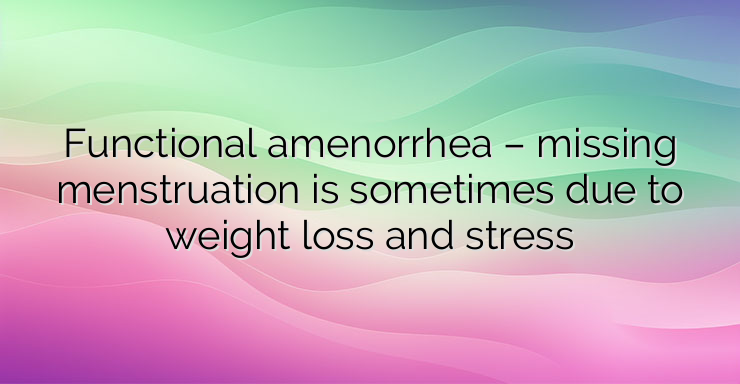A woman’s menstruation is a subtle cyclical process – a mirror of the integrity and coordination between the neuro-endocrine structures controlling sexual function. The hypothalamus, pituitary gland and ovaries form an axis of hormones with a stimulating effect on the subordinate, but also with an inverse, controlling connection to the superior unit. This coordination between the nervous tissue and the endocrine glands is expressed in periodic changes in the uterine mucosa corresponding to the reproductive function of the woman. Disorders of the menstrual cycle of hypothalamic origin are usually functional in nature and are one of the most common causes of amenorrhea – less often primary, and very often secondary. Changes in the secretion of gonadotropin-releasing hormone – pulse amplitude and frequency – affect the pulsatile secretion of pituitary gonadotropin hormones (follicle-stimulating and luteinizing), and they, in turn, engage estrogen production in the gonads. Brain tissue is one of the most vulnerable, which reflects its functional connection with a number of nervous structures, but also with the whole organism through humoral factors. Mental disorders, among which depression has a leading place, eating disorders such as anorexia and bulimia nervosa, but also other reasons for the reduction of fat tissue in the body, intense physical activity – usually in active athletes, as well as systemic emotional stress can be hidden behind the central type of amenorrhea. Adipose tissue is an active endocrine organ with a key humoral function in relation to the sexual axis. Falling below 10% of body weight leads to a disorder of the latter with a clinical manifestation in menstrual disorders, but also accompanying complications. One of the most important is the impact on bone metabolism and the risk of progression to osteoporosis. Hypothalamic amenorrhea can be provoked by hyperprolactinemia, in which the primary process is actually a pituitary adenoma. The formations usually do not have an aggressive nature that worsens the hormonal production of the pituitary gland, but prolactin has an inhibitory effect at the level of the hypothalamus, which affects the sex axis. Another cause of hyperprolactinemia is the intake of psychotropic medications – usually dopaminergic antidepressants. The hypothalamus and pituitary gland are involved in the regulation of multiple endocrine glands, and the hormones they produce do not have isolated sites of action, but rather form a network that can respond to any change in one of the axes. Diagnosing amenorrhea as functional hypothalamic requires, above all, the exclusion of other causes of menstrual disorders. Of course, the data on weight reduction against the background of food restriction or induction of vomiting, drug abuse, intense physical activity, the presence of significant emotional stress point to the nature of amenorrhea, especially if menstruation was regular before. Objective examination is important to rule out galactorrhea,hyperandrogenism (polycystic ovaries are a common etiology of menstrual disorders), hyperthyroidism, hyper- or hypocorticism as endocrine causes of amenorrhea. A gynecological examination is mandatory for the exclusion of genital malformations in primary amenorrhea, for the search for signs of hormonal deficiency. Hormonal studies include analysis of gonadotropic hormones and estrogens, but also prolactin. If an accompanying endocrine defect is suspected, the spectrum is expanded. Mental disorders, including eating disorders and even just fasting on some occasion, reflect many hormones and in these circumstances it is not unusual to measure high cortisol for example. Functional tests such as several days’ intake of medroxyprogesterone acetate or another progestin also speak to the functional integrity of the hypothalamic-pituitary axis. Imaging studies such as ultrasound are important for objectifying the findings in the ovaries, the presence of cystic changes in them, as well as for evaluating the quality of the uterine lining. When indicated, computed tomography or nuclear magnetic resonance is also performed to rule out a pathological finding in the pituitary gland. Treatment of hypothalamic functional amenorrhea requires, first of all, weight restoration and limitation of physical and emotional stress. Usually, by mastering these factors, which in most cases is not an easy task, menstruation is restored after a varying length of time. In case of desire for pregnancy, ovulation induction is carried out according to the recommendations and under the supervision of a specialist – endocrinologist and gynecologist. In connection with the risk of involvement of bone metabolism during amenorrhea and estrogen deficiency, it is appropriate to include a calcium preparation and vitamin D in prophylactic doses.Treatment of hypothalamic functional amenorrhea requires, first of all, weight restoration and limitation of physical and emotional stress. Usually, with the mastery of these factors, which in most cases is not an easy task, menstruation is restored after a varying length of time. In case of desire for pregnancy, ovulation induction is carried out according to the recommendations and under the supervision of a specialist – endocrinologist and gynecologist. In connection with the risk of involvement of bone metabolism during amenorrhea and estrogen deficiency, it is appropriate to include a calcium preparation and vitamin D in prophylactic doses.Treatment of hypothalamic functional amenorrhea requires, first of all, weight restoration and limitation of physical and emotional stress. Usually, by mastering these factors, which in most cases is not an easy task, menstruation is restored after a varying length of time. In case of desire for pregnancy, ovulation induction is carried out according to the recommendations and under the supervision of a specialist – endocrinologist and gynecologist. In connection with the risk of involvement of bone metabolism during amenorrhea and estrogen deficiency, it is appropriate to include a calcium preparation and vitamin D in prophylactic doses.


Leave a Reply